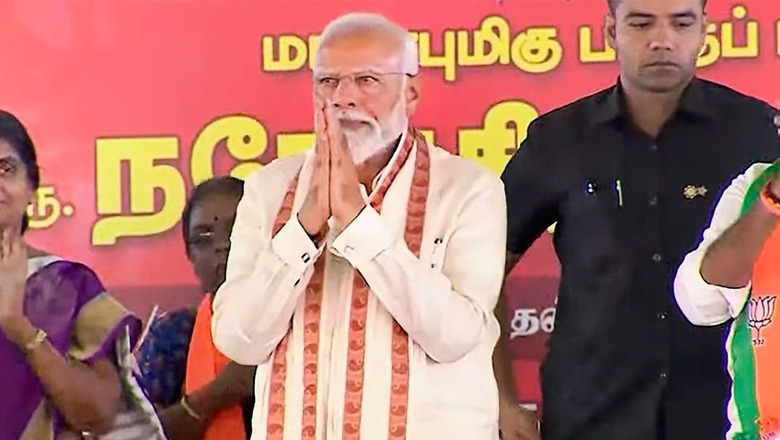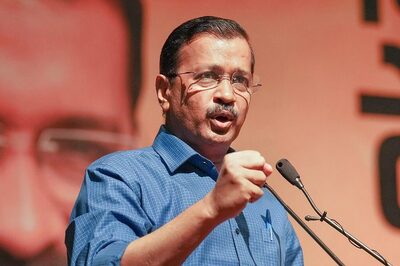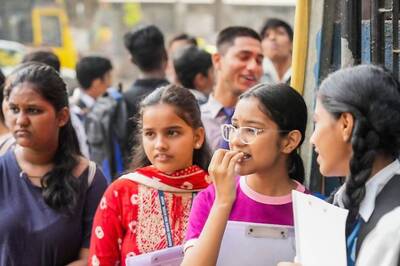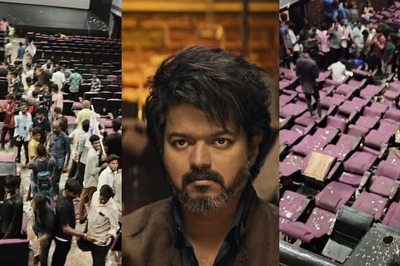
views
“Today we celebrate the Thiruvalluvar Day, commemorating the great Tamil sage whose profound wisdom in the Thirukkural guides us in several aspects of life. His timeless teachings inspire society to focus on virtue and integrity, fostering a world of harmony and understanding. We also reiterate our commitment to fulfilling his vision by embodying the universal values he championed,” Prime Minister Narendra Modi posted this on 16 January 2024 on his X handle.
In 2020, Modi quoted from Tamil classic Thirukkural to reinforce that Indian armed forces have always followed the time-honoured traditions of valour and honour. Addressing troops during a surprise visit to Ladakh, in 2020, Modi quoted saint-poet Thiruvalluvar’s couplet: “Maramanam manda vazhichelavu thetram yena nangey yemam padaikku.” It means, “That is, the tradition and credibility of valour, honour, dignified behaviour; these four qualities are the reflection of the army of any country. Indian forces have always followed this path.”
Again, in 2018, amidst applause, PM Modi during his address at the Defence Expo, quoted Thiruvalluvar’s couplet in Tamil extemporaneously. “Thottanaith thoorum manarkeni maandharku, kattranaithu thoorum arivu,” he said and explained the essence of the couplet. It basically means: “In sand and soil the deep you delve, you reach the spring below. The more you learn the freer streams of wisdom flow”.
No Prime Minister before Modi has so consistently and persistently showcased to the world, Tamil culture and its literary wealth. At the inauguration of the new Parliament building in May2023, Prime Minister Modi placed the historical and sacred Sengol in the Parliament House. Over 21 Adheenams from Chennai participated in the inauguration ceremony, prominent among them being the Dharmapuram Adheenam, Palani Adheenam, Virudhachalam Adheenam, and Thirukoyilur Adheenam, from Chennai. PM Modi took a decision to adopt Sengol as a national symbol of the Amrit Kaal.
Talking about the installation of ‘Sengol’, a symbol of justice, Ambalavana Desiga Paramachariya Swamigal of Thiruvavaduthurai Adheenam, said that it is a matter of pride for Tamil Nadu that Sengol is being given its significance. Lord Mountbatten got the Sengol and it was given to former PM Jawaharlal Nehru in 1947, as a symbol of transfer of power. However, Nehru discarded the Sengol in an obscure museum, making a mockery of national pride, including Tamil pride.
The DMK and the Congress are against Tamil culture and traditions. When PM Modi installed the sacred Sengol in the new Parliament, the DMK and Congress raised questions on the move.
External Affairs Minister S Jaishankar recently took the bull by the horns, saying the Katchatheevu issue had been “hidden too long from the gaze of the public”. The rights and livelihood of Indian fishermen were compromised by “ceding” this island to Sri Lanka, way back in 1974, by Indira Gandhi who was the Prime Minister then and DMK’s M Karunanidhi, who was the Chief Minister of Tamil Nadu at that time. This small island was administered by the British in the colonial era. Historically, the Raja of Ramnad or present-day Ramanathapuram in Tamil Nadu is said to have owned the island, which later became part of the Madras Presidency, in the 17th century. In the medieval times, the erstwhile Kingdom of Jaffna (area now in present-day Sri Lanka) owned this island. By the 1920s, both Sri Lanka and India wanted it exclusively for fishing and the dispute remained unsettled for decades after that.
Both countries became independent in the mid/ later part of the 1940s and the dispute dragged on. The dispute was formally raised by Sri Lankan Prime Minister Dudley Senanayake on his official visit to India in December 1968. He discussed it with the then PM Indira Gandhi. New Delhi and Colombo worked towards settling the dispute – once and for all over the next six years. However, in a sudden turn of events, following talks held between June 26 and 28, 1974, the Prime ministers of India and Sri Lanka, Indira Gandhi and Sirimavo Bandaranaike respectively, signed an agreement to demarcate the boundary between the two countries in the waters from Palk Strait to Adam’s Bridge.
It was called the “Agreement between Sri Lanka and India on the Boundary in Historic Waters between the two Countries and Related Matters of 1974”. Alas, there was nothing historic about this agreement for India, because Indira Gandhi in one fell sweep handed over 285 acres to Sri Lanka, calling Katchatheevu merely an “uninhabited cluster of land and rocks”. This was nothing but sheer cowardice on Indira Gandhi’s part. She simply wanted to get rid of a festering issue, could not handle the pressure of the Opposition and just succumbed.
A joint statement was issued on June 28, 1974, and it was pointed out that “this boundary falls one mile off the west coast of the uninhabited Katchatheevu”. Article 4 of the agreement stipulated that each State shall have sovereignty and exclusive jurisdiction and control over the waters, the Islands, the Continental Shelf and the subsoil on its side of the Maritime boundary in the Palk Strait and Palk Bay and Katchatheevu Island was determined as falling within Sri Lankan waters.
However, there was a catch” The Article added that “Indian fishermen and pilgrims would enjoy access to the island as before and would not be required by Sri Lanka to obtain travel documents or visas for these purposes”. The 1974 agreement was followed by a second one in 1976: “The Agreement between India and Sri Lanka on the Maritime Boundary between the two countries in the Gulf of Mannar and the Bay of Bengal and Related Matters of 1976”.
After the two agreements were signed in 1974 and 1976, India lost whatever control it had on Katchatheevu, in a classic case of how the Congress and DMK combine of Indira Gandhi and Karunanidhi sabotaged Indian interests and the interests of our fishermen in Tamil Nadu. This was no ordinary give and take as part of any border negotiations, which often happens in diplomacy. This was an abject surrender by the DMK and the Congress in 1974.
Ironically, bilateral ties between India and Sri Lanka were supposed to improve post this agreement, but that remained a pipedream and if anything, relations between the two countries only worsened under Indira’s son, Rajiv Gandhi, whose misadventures with the LTTE are only too well known.
Though our fishermen were supposed to continue enjoying access to Katchatheevu for their livelihood, as the years rolled by, that access became thinner and the DMK did not even shed crocodile tears at the plight of Tamil Nadu’s fishermen. “Rhetoric aside, DMK has done nothing to safeguard Tamil Nadu’s interests. New details emerging on Katchatheevu have unmasked the DMK’s double standards totally. Congress and the DMK are family units. They only care for their own sons and daughters’ rise. They don’t care for anyone else. Their callousness on Katchatheevu has harmed the interests of our poor fishermen and fisherwomen in particular,” Prime Minister Modi wrote on X recently, exposing the Congress-DMK combine.
“Eye opening and startling! New facts reveal how Congress callously gave away Katchatheevu. This has angered every Indian and reaffirmed in people’s minds- we can’t ever trust Congress! Weakening India’s unity, integrity and interests has been Congress’ way of working for 75 years and counting,” PM Modi wrote in yet another post on X.
It is pertinent to reinforce here that by relinquishing India’s rights on Katchatheevu under a lop-sided agreement, Indian interests, particularly those of our fishermen in coastal Tamil Nadu were compromised irrevocably.
But compromising India’s territorial sovereignty is not alien to either the DMK or the Congress. Who gave up 38,000 sq km of Aksai Chin, parts of Chabji valley, Tia Pangnak,Demjok and Chumur, to the Chinese on a golden platter? Who gave up India’s rights on Coco Islands to Burma (present-day Myanmar)? Who gave up parts of Rann of Kutch to Pakistan? Who signed the lame-duck Panchsheel agreement in 1954? Who capitulated in front of Chinese aggression in 1962? Well, the answer to all these questions is, Congress. Why did Indira Gandhi not ask for the return of 54 Indian PoWs from the 1965 and 1971 wars, while releasing 93,000 Pakistani PoWs, post the Shimla accord? Oman offered to sell Gwadar to India in the 1950s but Jawaharlal Nehru, the then PM, declined the offer. Pakistan thereafter bought it for 3 million pounds in 1958. Today, Gwadar is a strategic port and also of considerable geo-political significance. Needless to add, treating strategic Indian territories as their personal fiefdoms and handing them over to external Parties, has been the modus-operandi of the Nehruvian ilk.
MK Stalin and before that his father Karunanidhi of the DMK brought up the Katchatheevu issue ahead of every Assembly election in Tamil Nadu, simply to incite passions and inflame the public. The idea of forming a new nation State called “Dravida Nadu” has long been a part of DMK’s devious agenda. But to understand this notion of “Dravida Nadu”, we must know the history of Dravidian politics. It all began with the Justice Party in 1916. This party fundamentally stood for non-Brahmins (which to them meant “Dravidians”) and treated North Indians as outsiders.
Brahmins were labeled as “Aryan colonialists”. The central theme to Dravidianism, in their eyes, was atheism. This movement got stronger by the day. In fact, EP Ramasamy (famously called Periyar), asked for help from Mohammad Ali Jinnah to get a separate country. Jinnah only had lip-service to offer with his own selfish motives. In simple words, he offered none of the support that Ramasamy (Periyar) desperately hoped for.
Eventually, by 1962, the Dravida Nadu movement withered away because of growing Sino-Indian tensions and a constitutional amendment, invalidating any advocacy of secessionism. Yet, time and again, the DMK (which is an offspring of the erstwhile Justice Party), found itself invoking Dravidianism, purely for political currency. But whether one speaks Tamil, Punjabi, Marathi, Konkani, Assamese, Maithili or Hindi, one’s identity is Indian, something which DMK does not believe in. The idea of One India has always been alien to the DMK. That alone should be reason enough for the Tamizh people to reject the DMK.
The very core of DMK’s hardline Periyarist stand on most issues is driven by a visceral hatred for not just Brahmins but all Hindus and anything that is remotely Hindi in its ethos. India is a multi-lingual, multi-racial and a multi-religious country with over 80% Hindu population. And what an irony that under the garb of fighting for a casteless society, most DMK leaders who are converted Crypto Christians, never abuse any other religion, except Hinduism. CM of Tamil Nadu, MK Stalin’s son Udhayanidhi Stalin, who is also a minister in his father’s Cabinet, compared Sanatan Dharma to Dengue, Malaria, Rabies and Covid. What is worse, Congress President Mallikarjun Kharge’s son, Priyanka Kharge, who is a minister in the Siddaramaiah Cabinet in Karnataka, endorsed Udhayanidhi’s rabid Hinduphobic bigotry.
The false propaganda that South India pays higher taxes and “subsidises the North”, is yet another classic example of mischievous fear-mongering by the DMK to divide Hindus along parochial, regional and linguistic lines. Proposing a common “Dravidian Identity” holds no water in an informed New India taking shape under PM Modi. Should any self-respecting Hindu ever vote for the DMK or Congress? That is something every conscientious Hindu needs to dwell upon.
Politicians who divide and play on peoples’ emotions must know that these methods of anti-national divisive politics shall not work in this country. Along with banking on a myth about the so-called “Aryan invasion theory”, Dravida Nadu has zero practicality to it, as it fails the simplest tests it is put through, even hypothetically speaking. At a Dravida Munnetra Kazhagam (DMK) local body representatives’ gathering in Namakkal, Tamil Nadu, a few years back, A. Raja warned the Centre ‘not to compel’ the party to resurrect the demand for a separate Tamil Nadu.
Speaking at the function, Raja said, “DMK has given up the call for separate Tamil Nadu. But our ideological godfather Periyar demanded a separate Tamil Nadu till his death. We have kept aside that demand temporarily and accepted federalism for the country’s integrity and democracy”. The limited point is this—the DMK, going by the unbecoming statements of its top brass, has been largely anti-India, anti-Hindu and anti-poor. DMK’s A. Raja is a Member of Parliament from the Nilgiris. Raja, in a veiled manner, was advocating for an independent Tamil Nadu, as proposed by Periyar, recognised as the “Father of the Dravidian Movement.”
It is pertinent to mention that A. Raja was the Information Technology minister under Manmohan Singh’s UPA government when the 2G spectrum fraud was exposed. It should be noted that the DMK partners with the Indian National Congress (INC) both in Tamil Nadu and otherwise too. It is also worth noting that Rahul Gandhi, the Gandhi scion and Congress MP from Wayanad, recently asserted that India is not a nation, at a Cambridge University event, but more like a ‘Union of States’ like the European Union. A. Raja’s views appear to be in line with Rahul Gandhi’s remarks, which encourage the idea of India’s balkanisation.
That both DMK and Congress are anti-Hindu, was evident when Hindu activist and Indu Makkal Katchi Chief, Arjun Sampath, was arrested for protesting against destruction of temples in Coimbatore, sometime back. Appeals by Indic activists for funds to help a school in Tirunelveli, Tamil Nadu, have gone unanswered by the Stalin regime. The decades-old issue of anti-Hindi, anti-Hindu and anti-North-India politics that dominate Chief Minister MK Stalin’s divisive agenda have been in the news time and again. These are just ploys to deflect attention of the voters from Stalin’s mammoth failures. Stalin’s flood management post Cyclone Michaung last year, has been a complete disaster and the entire rescue and relief work was carried out largely by the National Disaster Response Force (NDRF). The apex body for disaster management is the National Disaster Management Authority (NDMA). NDRF functions under NDMA. The Chairman of NDMA is Prime Minister Modi.
Not only flood management, even otherwise, Chief Minister Stalin has a very poor track record in handling Tamil Nadu’s economy, with inflation in 2023 well over 9% in Tamil Nadu, for months together, when the national retail inflation rate was much lower. Also, Power DISCOMs, Tamil Nadu Generation and Distribution Corporation Ltd (TANGEDCO) and other utilities in Tamil Nadu have accumulated debt of over Rs 2 lakh crore, with a looming electricity crisis. Additionally, Tamil Nadu had an outstanding liability of over Rs 5.38 lakh crore at the end of March 2023, on funds raised through the issue of bonds.
Former Finance minister of Tamil Nadu, P. Thiaga Rajan, who spent the better part of his stint trolling people who disagreed even remotely with him, was a complete disaster and though he was subsequently replaced, he continues to handle the Information Technology department. The lack of talent in Stalin’s cabinet is all too evident. Senthil Balaji, a senior DMK leader is an accused in the Cash for Jobs’ scam, while K. Ponmudy, another close aide of Stalin, was indicted by the Madras High Court in the disproportionate assets’ case. In the midst of all this, it is the Tamizh people who have borne the brunt of DMK’s lethargy, unbridled corruption and gnawing incompetence.
Over the grievances raised by migrant Bihari labourers who say they have been facing harassment, the inept Stalin regime has done nothing to resolve this issue. The Aryan Invasion Theory, which never had any factual basis, declared North Indians as ‘foreign settlers or invaders’ and South Indians as the Dravidians, the ‘original’ inhabitants of the Indian subcontinent. It is not surprising that Stalin is using the same rhetoric that the British used, to divide and rule. But the Tamizh people are very wise and have now begun to see through Stalin-istic propaganda.
The politics of hate has been propagated so widely and for so long by the DMK that it is now a part of the mainstream in Tamil Nadu’s political discourse. As stated earlier, the vague and baseless ideas of the so-called Dravidian identity, as opposed to the larger Indian identity, have been the basis of the Periyarist movement and its offspring, the DMK. The DMK’s brand of politics is divisive and anti-India. In recent years, especially after Narendra Modi came to power in 2014, other parties, including the Congress have tried to lean on the same Dravidian political ideology to gain some foothold, and to paint the Modi government as bad.
Such is the extent of duplicity expressed by the Congress that they even contradicted the 2011 report by their own government, undersigned by their leader and the then Home Minister P Chidambaram, to propagate the Hindi language all over India. When the Modi government after 2014 worked on implementing the points recommended in the said report, Congress and its leaders were one of the loudest detractors.
Of the 511 poll promises Stalin gave in 2021, most remain unfulfilled. The DMK is a party that couldn’t construct even a new Bus terminus in Coimbatore in the last 3 years; it is today promising a stadium that should be regarded as nothing more than yet another empty promise to mislead the electorate. PM Modi, on the contrary, has been toiling 24×7 for the Tamizh people. Modi inaugurated and laid the foundation stone of multiple development projects worth about Rs 17,300 crore at Thoothukudi in Tamil Nadu, in February, 2024.
In Tamil Nadu, he laid the foundation stone of the Outer Harbor Container Terminal at V.O. Chidambaranar Port and launched India’s first indigenous green hydrogen fuel cell inland waterway vessel under the Harit Nauka initiative. During his visit, PM Modi dedicated rail projects for doubling the Vanchi Maniyachchi-Nagercoil rail line, developed for Rs 1,477 crore, and dedicated four road projects in Tamil Nadu, developed at a total cost of about Rs 4,586 crore.
Don’t forget, prior to the consecration ceremony at the splendid Ram Mandir on 22 January,2024, Modi visited the Arichal Munai, near Dhanushkodi in Tamil Nadu, as part of his Ramayana-connect tour. Modi also performed puja at Sri Kothandarama Swamy temple. The name Kothandarama means Rama with the bow. It is located in Dhanushkodi. It is said that this is where Ravana’s brother Vibhishana first met Lord Ram and asked him for refuge. Some legends also say that this is the place where Lord Ram conducted the coronation of Vibhishana.
Earlier, PM Modi visited Sri Ranganathaswamy Temple in Tiruchirappalli and Sri Arulmigu Ramanathaswamy Temple in Rameswaram in Tamil Nadu. Clearly, driven by his unconditional love for the people of Tamil Nadu, Modi has always given top notch priority to this Southern State, be it in terms of development projects or with respect to furthering the cause of Tamil Nadu’s cultural heritage and ethos. In fact, each time Modi visited Tamil Nadu in the last few years, he made it a point to wear the “Veshti”, sending out a strong message that he feels at home when he is among the people of Tamil Nadu, who are the proud inheritors of a rich cultural legacy. As they say, small gestures are often the harbingers of big change.
(Sanju Verma is an Economist, National Spokesperson of the BJP and the Bestselling Author of ‘The Modi Gambit’. Views expressed in the above piece are personal and solely those of the author. They do not necessarily reflect News18’s views)




















Comments
0 comment